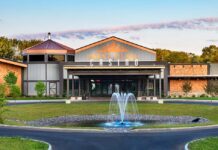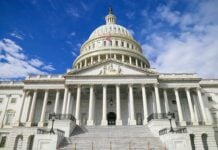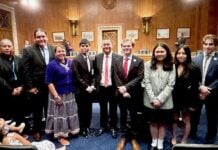ANCHORAGE, AK – Secretary of the Interior Deb Haaland wrapped up a multi-day visit to Alaska, where she highlighted how historic resources from President Biden’s Investing in America agenda are supporting Alaska’s tribal communities by bolstering climate resiliency, investing in co-stewardship and salmon conservation, and strengthening local economies. To date, the Biden-Harris administration has announced over $5.3 billion for the State of Alaska to further these goals.
Secretary Haaland, Solicitor Bob Anderson, Assistant Secretary for Indian Affairs Bryan Newland, and Senior Advisor Raina Thiele participated in the 2023 Alaska Federation of Natives Convention in Anchorage over several days. Secretary Haaland’s remarks underscored the Department of the Interior’s commitment to supporting tribes dealing with the impacts of the climate crisis through new investments from the Bipartisan Infrastructure Law and Inflation Reduction Act. The Department has focused significant resources in Alaska that range from the launch of a new Voluntary Community-Driven Relocation program and resources for wildfire resilience to programs to address legacy pollution left by extractive industries and the Department’s new “Gravel to Gravel” initiative.
The Interior team traveled to the community of Ninilchik to tour the Deep Creek Watershed fish passage. With more than $1.3 million in funding from the Bipartisan Infrastructure Law, the project will help remove two fish barriers and provide safe, efficient, and reliable access to subsistence resources. Removal of these barriers will provide access to spawning and rearing habitat for Pink, Coho and Chinook salmon as well as Steelhead Trout and Dolly Varden. The project is a partnership between the U.S. Fish and Wildlife Service, the Kenai Peninsula Borough, the Ninilchik Native Association Inc., and the Ninilchik Traditional Council, an example of the collaborative partnerships at the center of President Biden’s Investing in America agenda.
Secretary Haaland also visited two sites making great use of funds from the Great American Outdoors Act (GAOA). The Campbell Tract, a 730-acre parcel managed by the Bureau of Land Management, is located in the heart of Alaska’s largest urban area that provides outdoor recreation opportunities for more than 500,000 visitors annually. With a $3.5 million investment from the GAOA, Campbell Tract’s Campbell Creek Science Center is making improvements to traffic flow and public safety by eliminating hazardous pedestrian and vehicle conflicts.
Secretary Haaland traveled to Kenai National Wildlife Refuge to tour various GAOA-funded projects. The refuge received $13.5 million in GAOA funding to address more than 30 deferred maintenance backlogged projects, including improving river access and employee housing, creating a safer and more ecologically friendly access for visitors, and installing new culverts to improve fish passage in the Kenai Peninsula.
The GAOA established the National Parks and Public Land Legacy Restoration Fund (GAOA LRF), a bipartisan investment that improves visitor experiences, bolsters climate resilience, and invests in the economy by creating good-paying jobs in national parks, wildlife refuges, recreation areas and Bureau of Indian Education (BIE)-funded schools. Since 2021, GAOA LRF projects have supported an average of 17,000 jobs and generated an average of $1.8 billion for local economies annually. GAOA’s LRF funding sunsets after fiscal year 2025 and would need to be reauthorized by Congress to continue the efforts underway to address significant infrastructure needs across public lands.
During her visit, Secretary Haaland also traveled to Seward to visit the Alaska Sealife Center, a unique facility that maintains a public aquarium with species native to Alaska and participates in marine research and wildlife response. She also visited the Alutiiq Pride Marine Institute, an intertribal research facility focused on coastal and marine ecosystem health. At the center, Secretary Haaland was briefed on the long-standing partnership with the U.S. Fish and Wildlife Service and heard from experts on their work to research and recover Alaska’s marine environment. At the institute, the Secretary heard from tribal leaders and staff about their work to keep Alaska’s ecosystems resilient for current and future generations.

Secretary Haaland and Assistant Secretary Newland hosted the 10th stop on “The Road to Healing” at the Alaska Native Heritage Center. This tour across the country is providing Native survivors of the federal Indian boarding school system and their descendants an opportunity to share their experiences as part of the Department’s Federal Indian Boarding School Initiative.
This trip to Alaska – the Secretary’s third in 2.5 years – is the latest in a series of visits from senior Interior Department leaders. In August, Deputy Secretary Tommy Beaudreau visited the state with Senior Advisor to the President and White House Infrastructure Implementation Coordinator Mitch Landrieu to highlight how investments from President Biden’s Investing in America agenda are supporting tribal communities impacted by climate change and advancing co-stewardship and salmon conservation across the Yukon, Kuskokwim and Norton Sound Region. In April, Assistant Secretary Newland and his team toured Alaska where he highlighted investments to advance tribal climate resilience and combat the crisis of missing and murdered Indigenous peoples.















































